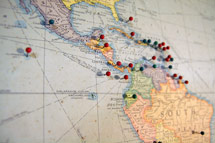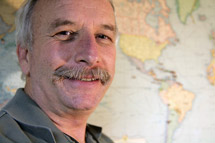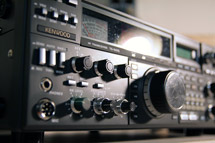
Handy Links
SLAC News Center
SLAC Today
- Subscribe
- Archives: Feb 2006-May 20, 2011
- Archives: May 23, 2011 and later
- Submit Feedback or Story Ideas
- About SLAC Today
SLAC News
Lab News
- Interactions
- Lightsources.org
- ILC NewsLine
- Int'l Science Grid This Week
- Fermilab Today
- Berkeley Lab News
- @brookhaven TODAY
- DOE Pulse
- CERN Courier
- DESY inForm
- US / LHC
SLAC Links
- Emergency
- Safety
- Policy Repository
- Site Entry Form

- Site Maps
- M & O Review
- Computing Status & Calendar
- SLAC Colloquium
- SLACspeak
- SLACspace
- SLAC Logo
- Café Menu
- Flea Market
- Web E-mail
- Marguerite Shuttle
- Discount Commuter Passes
-
Award Reporting Form
- SPIRES
- SciDoc
- Activity Groups
- Library
Stanford
Around the Bay
SLAC Tunes In to Amateur Radio
Hanging in the basement of SLAC's Auxiliary Control Building is a world map that's been stuck full of pushpins. A small forest of them has sprung up in Central Europe, and several are vying for New Zealand's limited real estate. There's even one lonely pin in the no-man's land between the tip of South America and the snaking arm of the Antarctic Peninsula.
Each pin represents a contact made over the airwaves by a member of the SLAC Radio Service Organization, a ham radio group that was founded in 1965 and included former SLAC Director Burton Richter at one point. The organization has been inactive in recent years, but Facilities Instrumentation Technician Ron Badger and Assistant Fire Marshal and Emergency Management Coordinator Lance Lougée are seeking radio enthusiasts and curious newcomers to help restart it. Interested staffers are invited to an event at SLAC this Saturday to learn more about the world of amateur radio.
Don't let the name fool you—"amateur" radio is "actually very professional," Badger said. So-called "hams" have to test for their amateur radio license, which comes in three classes. Amateurs also tend to have considerable technical knowledge. This becomes apparent in how quickly conversations on the airwaves turn to shop-talk, with hams swapping antenna lore, bragging about wattage and comparing transceiver model numbers. Amateurs who contact each other exchange "call signs," and later look up their new contacts in an online database. Badger has spoken to hams from England and France to Australia and Japan.
"You can communicate with anyone in the world," Badger said. "The biggest barrier is the language, not the distance." Badger recalled how excited he was as a 12-year-old to make his first contact, on a set he'd built himself. "I called somebody in Kansas, and he was so mad because I didn't have a license."
According to Lougée, members of the SLAC Radio Service Organization would learn about this decades-old hobby and have the chance to train for their licenses, all while providing an important service.
"During an emergency, radios are the only form of communication that you can actually depend on," Lougée said. "It's a redundant, robust, dynamic system." While cellular networks can be overloaded by frantic calls or even fail completely, a ham can construct a viable station with metal wire and a car battery, providing instant outreach. Each station is fully independent, meaning the overall network is free from "choke-points" and resistant to flooding.
As a consequence, amateur radio operators have come to the rescue in many disaster situations. In the aftermath of Hurricane Katrina, for instance, hams swarmed to the Gulf Coast by the hundreds, providing the main form of communication in devastated areas for the first two weeks.
"The ham community is an integral part of a competent response," Lougée said. He and Badger hope for a SLAC Radio Service Organization membership of around 40 SLACers at all radio competency levels. The group could "support SLAC in its ability to talk to the community, Stanford, and the DOE at a distance."
Members will have the chance to work with new technology that allows radio to transmit data and even video from otherwise blacked-out areas to the nearest internet node, making information easily transmissible worldwide. "We'll be relying on traditional communications as well as new technologies to get a message out," Lougée said.
Lougée plans to coordinate a field exercise with other northern California Department of Energy labs, with hopes of expanding to include other parts of the country. SLAC hams would simulate an emergency situation, testing their ability to talk on an improvised set-up to stations far and wide. "I want to make this as interesting and fun for them as possible, with an eye towards deployment in an emergency," Lougée said. "This is a critical communication infrastructure for SLAC."
Anyone wishing to join the SLAC Radio Service Organization can send an email to o Ron Badger. There are no dues, no license is required and members may participate at any level. Badger and Lougée invite anyone who wants to learn more to drop in to an informal meeting at 12:30 pm, Saturday, February 21, in Panofsky Auditorium, in conjunction with the Foothills Amateur Radio Society's monthly AmTech Day. There will be free barbecue, informational sessions, and the chance for unlicensed newcomers to experience the simple magic of amateur radio—pulling a human voice out of the ionosphere's hum and whine.
—Lauren Schenkman
SLAC Today, February 17, 2009


